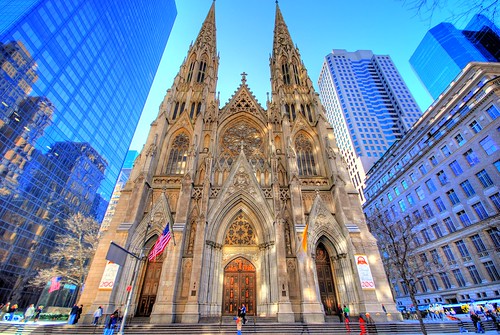Joseph Campbell once said that an effective rule of thumb for determining who controls a region is to ascertain what the the tallest building is. In the middle ages, the tallest structure was always the church, from the Hagia Sophia to the village parish. In the industrial revolution, the tallest structures became the buildings of the state. Now, the tallest buildings are the skyscrapers, the centers of finance.
Campbell had an unfortunate tendency to overgeneralize, but in the case of the Axis Mundi of the of the French, he is 100% correct. As for the Axis Mundi of the Irish, he's utterly, dead wrong.
The Axis Mundi of the French world is the easiest.

What were you expecting, a giant metal frog?
The Eiffel Tower from its construction to this day has been the tallest structure in Paris. Aside from a few transmitting towers and a bridge, it is the tallest structure in France. It is interesting to note how vigorously the French have defended their Axis Mundi from any possible contenders. The Tour Montparnasse, the lone skyscraper in the city limits of Paris (and still shorter than the Eiffel), was so hated that laws were passed forbidding any future skyscraper construction within the city limits.
The Axis Mundi of Irish Catholicism, and by extension most of Irish history, has been St. Patrick's Cathedral. Though not the tallest, the largest church in Ireland has been deaned by Jonathan Swift. Handel's Messiah saw its premiere in this building. The city with arguably the 2nd largest population of Irish in the world, New York, has its own.

St. Patrick's, lookin' feckin' majestic an' all that bollocks

A comically oversaturated image of St. Patrick's in New York.
It's interesting to compare the two by height. Dublin's dominates its landscape (the picture's a bit misleading, it's in a city), as Irish Catholicism dominated the country up until only the last generation or two. New York's is a midget, lost in the ocean of buildings and people that comprise Manhattan.
Still, the height issue does have some significance. An observational tower is the tallest building one has access to in Dublin today. The second-tallest? The pub atop the Guinness Storehouse. And many hackles are being raised by Bono of U2's plan to make his new recording studio the tallest building in the entire country.

I support this post.
ReplyDeleteI've been meaning to do one of these every week, on Mondays. Luckily there are many many more. I STRONGLY disagree that the Axis Mundi of the French is easiest. I'd say there's an easier one. I'll do it next week. But the Eiffel Tower is certainly the AM of France. It is far from the only structure rendered tallest in a city/nation by statute or custom, but it is certainly a very emblematic one. The Capitol in Washington is another. It is not the tallest building in the District, but the few others all have special exemptions, and no new building may exceed its height.
2) Axis Mundis? Heh. Hardly. The proper plural is Axes Mundorum. But that sounds so terribly awful that yours is good enough for me.
The curse of Billy Penn!
ReplyDeleteCity Hall in Center City Philly has a statue of William Penn on the top rotunda. For years there was a gentlemen's agreement that no building in the city would be taller than the top of Mr. Penn's hat.
But then in 1987, construction on One Liberty Plaza was finished, dwarfing Mr. Penn. And after several recent productive, successful seasons, Philly sports teams started to suck. Majorly. (Though they had a reputation before: see the famous "Phold" of the 60s.)
It continued that way for over 20 years, until construction finished on the Comcast Center in downtown Philly. There, construction workers put a small statue of (who else?) William Penn, an American flag, and an evergreen tree on the top, again making William Penn the tallest fellow in the city. The very next year, Phillies win the World Series for the first time in 28 years, Eagles go on to the NFC championship or some bullshittery, etc.
There's also a lot to be said for the Art Museum stairs as a sort of axis mundi (the famous scene from Rocky) but that's better saved for a whole post.
That story is incredible, and what this blagadingalong is all about.
ReplyDeleteHere's a question: were the stairs of the Art Museum a local axis before Rocky? Or was it Rocky which revealed the steps as an axis?
(Generally speaking, according to Mircea Eliade, the sacred is ALWAYS sacred. By that logic, my question is: did the people of Philadelphia KNOW that the stairs were a sacred mark before Rocky? Or was Rocky the revelation of the sacred (hierophany)?)
Well, the Art Museum itself is kind of this imposing, awe-inspiring structure. Within the plan of the city, it sits at the end of the Benjamin Franklin Parkway, a long, straight street that cuts diagonally through the city grid, decorated with flags of the world and trees on either side. It sits by itself, pretty much, in a way similar to the posted image of St. Patrick's in Dublin (though in reality it is more removed from the cityscape than St. Patrick's actually *is," having seen both in real life). There's certainly an existing atmosphere of something very much like sacredness. But I would say it wasn't truly revealed until Sylvester Stallone ran up those stairs.
ReplyDeleteSylvester Stallone, Priest of Philadelphia. Who would have guessed?
ReplyDeleteSylvester Stallone is the priest and the Rocky franchise is the gospel.
ReplyDelete